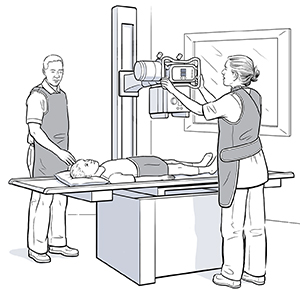When Your Child Needs an X-ray
When Your Child Needs an X-ray
During an X-ray exam, a small amount of radiation is used to produce pictures of bones and some internal organs. The resulting pictures (called X-rays or radiographs) can help the healthcare provider detect bone and joint problems. They can also be used to check organs, such as the heart or lungs. An X-ray exam takes only a few minutes.
Before the X-ray
What you need to do before your child has an X-ray:
Remove any metal objects (such as glasses, belts, or clothing with zippers) from your child’s body. These things can interfere with X-rays and affect the results.
Follow all other instructions given by the healthcare provider.
Let the technologist know
For your child’s safety, let the technologist know if your child:
Has had the same body part X-rayed before
Has metal in the body part being X-rayed
Has any health problems
Is taking any medicines
Is or may be pregnant
During the X-ray
An X-ray exam is done by a radiology technologist. A radiologist is also on call in case of problems. This is a healthcare provider trained to use X-rays to test or treat patients:
You can stay with your child in the X-ray room. You’ll be given a lead apron to wear for your safety. Pregnant women aren’t allowed in the X-ray room.
Your child may stand or sit or lie down on an X-ray table. This depends on the body part being X-rayed.
Movement affects the quality of the results. If your child can’t stay still during the exam, he or she may be held down.
A lead apron or shield is placed over your child’s reproductive organs. Other body parts (such as the thyroid) may also be covered.
The technologist is nearby and views your child through a window.
Your child may be asked to take a deep breath and hold it for a few seconds to improve X-ray results.
After the X-ray
What to expect after the X-ray:
There is a short wait while the X-rays are reviewed. More X-rays will need to be taken if the pictures are unclear.
Unless told not to, your child can return to his or her normal routine and diet right away.
The X-rays are reviewed by a radiologist, who may discuss early results with you. A report is sent to your child’s healthcare provider, who follows up with complete results.
Helping your child prepare
You can help your child by preparing him or her in advance. How you do this depends on your child’s needs:
Explain the exam to your child in brief and simple terms. Younger children have shorter attention spans, so do this shortly before the exam. Older children can be given more time to understand the exam in advance.
Make sure your child understands which body part(s) will be involved in the exam.
As best you can, describe how the exam will feel. X-rays are painless so your child won’t feel anything when pictures are taken.
Allow your child to ask questions.
Use play when helpful. This can involve role-playing with a child’s favorite toy or object. It may help older children to see pictures of what happens during the exam.
Possible risks and complications of an X-ray
Having an X-ray exam exposes your child to low doses of radiation. If an X-ray exam is ordered for your child, the healthcare provider has decided that its value outweighs any risk.
Updated:
October 03, 2017
Reviewed By:
Bass, Pat F. III, MD, MPH,Grossman, Neil, MD
